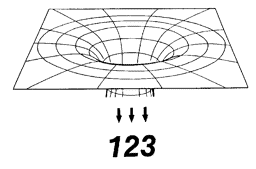 |
Science Frontiers ONLINE No. 86: Mar-Apr 1993 |
|
|
All roads lead to 123
 |
"Start with any number that is a string of digits -- , say, 9 288 759 -- and count the number of even digits, the number of odd digits, and the total number of digits it contains. These are 3 (three evens), 4 (four odds), and 7 (seven is the total number of digits), respectively. Use these digits to form the next string or number, 347. If you repeat the process with 347, you get 1, 2, 3. If you repeat with 123, you get 123 again. The number 123, with respect to this process and universe of numbers, is a mathematical black hole."
We have a black hole because we cannot escape, just as spaceships are doomed when captured by a physical black hole! You end up with 123 regardless of the number you start with. Other sorts of mathematical black holes exist, such as the Collatz Conjecture, but we must not fall into them because our printer awaits.
(Ecker, Michael; "Caution: Black Holes at Work," New Scientist, p. 38, December 19/26, 1992.)